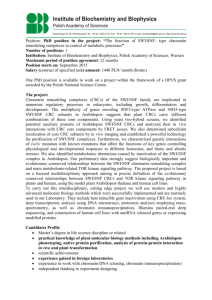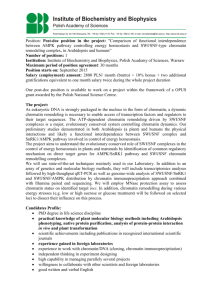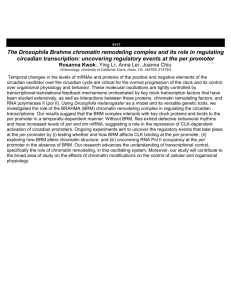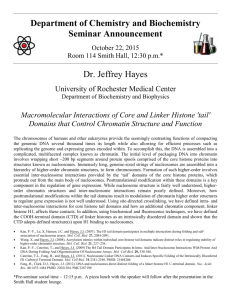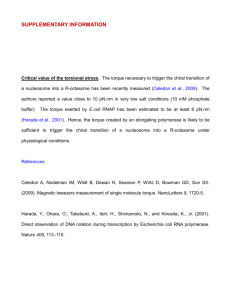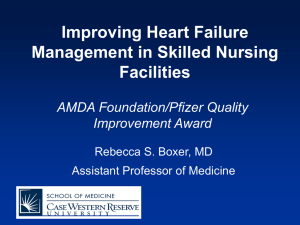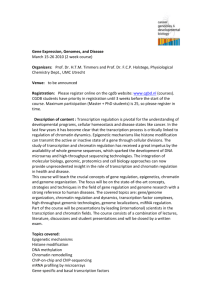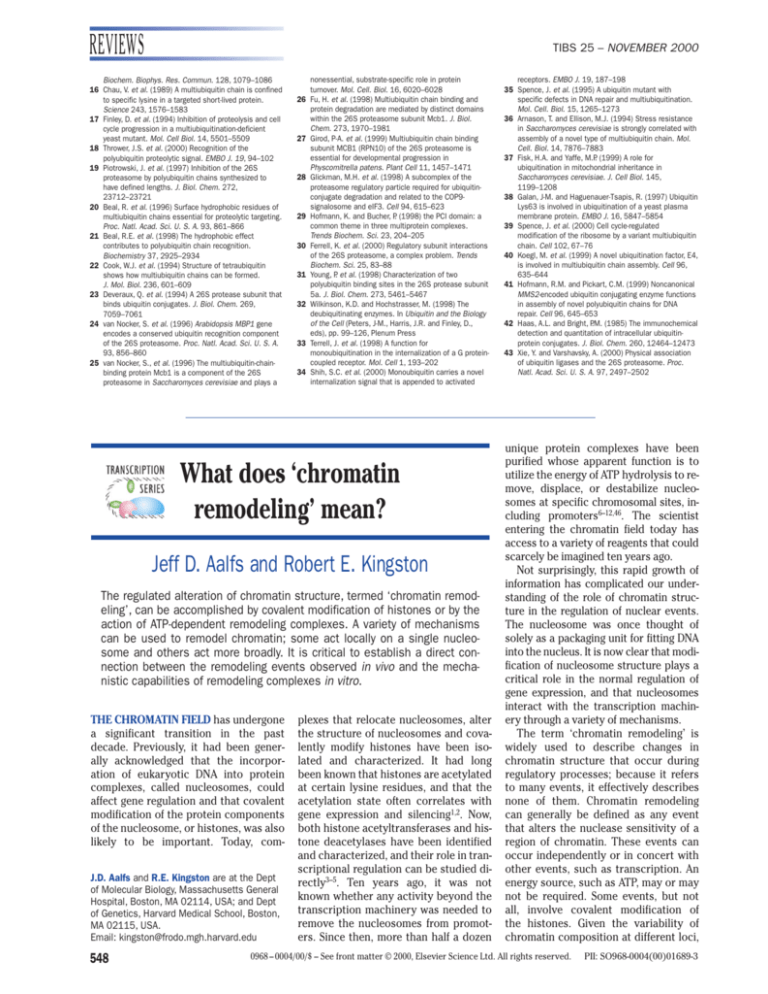
REVIEWS
TIBS 25 – NOVEMBER 2000
Biochem. Biophys. Res. Commun. 128, 1079–1086
16 Chau, V. et al. (1989) A multiubiquitin chain is confined
to specific lysine in a targeted short-lived protein.
Science 243, 1576–1583
17 Finley, D. et al. (1994) Inhibition of proteolysis and cell
cycle progression in a multiubiquitination-deficient
yeast mutant. Mol. Cell Biol. 14, 5501–5509
18 Thrower, J.S. et al. (2000) Recognition of the
polyubiquitin proteolytic signal. EMBO J. 19, 94–102
19 Piotrowski, J. et al. (1997) Inhibition of the 26S
proteasome by polyubiquitin chains synthesized to
have defined lengths. J. Biol. Chem. 272,
23712–23721
20 Beal, R. et al. (1996) Surface hydrophobic residues of
multiubiquitin chains essential for proteolytic targeting.
Proc. Natl. Acad. Sci. U. S. A. 93, 861–866
21 Beal, R.E. et al. (1998) The hydrophobic effect
contributes to polyubiquitin chain recognition.
Biochemistry 37, 2925–2934
22 Cook, W.J. et al. (1994) Structure of tetraubiquitin
shows how multiubiquitin chains can be formed.
J. Mol. Biol. 236, 601–609
23 Deveraux, Q. et al. (1994) A 26S protease subunit that
binds ubiquitin conjugates. J. Biol. Chem. 269,
7059–7061
24 van Nocker, S. et al. (1996) Arabidopsis MBP1 gene
encodes a conserved ubiquitin recognition component
of the 26S proteasome. Proc. Natl. Acad. Sci. U. S. A.
93, 856–860
25 van Nocker, S., et al. (1996) The multiubiquitin-chainbinding protein Mcb1 is a component of the 26S
proteasome in Saccharomyces cerevisiae and plays a
26
27
28
29
30
31
32
33
34
nonessential, substrate-specific role in protein
turnover. Mol. Cell. Biol. 16, 6020–6028
Fu, H. et al. (1998) Multiubiquitin chain binding and
protein degradation are mediated by distinct domains
within the 26S proteasome subunit Mcb1. J. Biol.
Chem. 273, 1970–1981
Girod, P-A. et al. (1999) Multiubiquitin chain binding
subunit MCB1 (RPN10) of the 26S proteasome is
essential for developmental progression in
Physcomitrella patens. Plant Cell 11, 1457–1471
Glickman, M.H. et al. (1998) A subcomplex of the
proteasome regulatory particle required for ubiquitinconjugate degradation and related to the COP9signalosome and eIF3. Cell 94, 615–623
Hofmann, K. and Bucher, P. (1998) the PCI domain: a
common theme in three multiprotein complexes.
Trends Biochem. Sci. 23, 204–205
Ferrell, K. et al. (2000) Regulatory subunit interactions
of the 26S proteasome, a complex problem. Trends
Biochem. Sci. 25, 83–88
Young, P. et al. (1998) Characterization of two
polyubiquitin binding sites in the 26S protease subunit
5a. J. Biol. Chem. 273, 5461–5467
Wilkinson, K.D. and Hochstrasser, M. (1998) The
deubiquitinating enzymes. In Ubiquitin and the Biology
of the Cell (Peters, J-M., Harris, J.R. and Finley, D.,
eds), pp. 99–126, Plenum Press
Terrell, J. et al. (1998) A function for
monoubiquitination in the internalization of a G proteincoupled receptor. Mol. Cell 1, 193–202
Shih, S.C. et al. (2000) Monoubiquitin carries a novel
internalization signal that is appended to activated
What does ‘chromatin
remodeling’ mean?
Jeff D. Aalfs and Robert E. Kingston
The regulated alteration of chromatin structure, termed ‘chromatin remodeling’, can be accomplished by covalent modification of histones or by the
action of ATP-dependent remodeling complexes. A variety of mechanisms
can be used to remodel chromatin; some act locally on a single nucleosome and others act more broadly. It is critical to establish a direct connection between the remodeling events observed in vivo and the mechanistic capabilities of remodeling complexes in vitro.
THE CHROMATIN FIELD has undergone
a significant transition in the past
decade. Previously, it had been generally acknowledged that the incorporation of eukaryotic DNA into protein
complexes, called nucleosomes, could
affect gene regulation and that covalent
modification of the protein components
of the nucleosome, or histones, was also
likely to be important. Today, comJ.D. Aalfs and R.E. Kingston are at the Dept
of Molecular Biology, Massachusetts General
Hospital, Boston, MA 02114, USA; and Dept
of Genetics, Harvard Medical School, Boston,
MA 02115, USA.
Email: kingston@frodo.mgh.harvard.edu
548
plexes that relocate nucleosomes, alter
the structure of nucleosomes and covalently modify histones have been isolated and characterized. It had long
been known that histones are acetylated
at certain lysine residues, and that the
acetylation state often correlates with
gene expression and silencing1,2. Now,
both histone acetyltransferases and histone deacetylases have been identified
and characterized, and their role in transcriptional regulation can be studied directly3–5. Ten years ago, it was not
known whether any activity beyond the
transcription machinery was needed to
remove the nucleosomes from promoters. Since then, more than half a dozen
receptors. EMBO J. 19, 187–198
35 Spence, J. et al. (1995) A ubiquitin mutant with
specific defects in DNA repair and multiubiquitination.
Mol. Cell. Biol. 15, 1265–1273
36 Arnason, T. and Ellison, M.J. (1994) Stress resistance
in Saccharomyces cerevisiae is strongly correlated with
assembly of a novel type of multiubiquitin chain. Mol.
Cell. Biol. 14, 7876–7883
37 Fisk, H.A. and Yaffe, M.P. (1999) A role for
ubiquitination in mitochondrial inheritance in
Saccharomyces cerevisiae. J. Cell Biol. 145,
1199–1208
38 Galan, J-M. and Haguenauer-Tsapis, R. (1997) Ubiquitin
Lys63 is involved in ubiquitination of a yeast plasma
membrane protein. EMBO J. 16, 5847–5854
39 Spence, J. et al. (2000) Cell cycle-regulated
modification of the ribosome by a variant multiubiquitin
chain. Cell 102, 67–76
40 Koegl, M. et al. (1999) A novel ubiquitination factor, E4,
is involved in multiubiquitin chain assembly. Cell 96,
635–644
41 Hofmann, R.M. and Pickart, C.M. (1999) Noncanonical
MMS2-encoded ubiquitin conjugating enzyme functions
in assembly of novel polyubiquitin chains for DNA
repair. Cell 96, 645–653
42 Haas, A.L. and Bright, P.M. (1985) The immunochemical
detection and quantitation of intracellular ubiquitinprotein conjugates. J. Biol. Chem. 260, 12464–12473
43 Xie, Y. and Varshavsky, A. (2000) Physical association
of ubiquitin ligases and the 26S proteasome. Proc.
Natl. Acad. Sci. U. S. A. 97, 2497–2502
unique protein complexes have been
purified whose apparent function is to
utilize the energy of ATP hydrolysis to remove, displace, or destabilize nucleosomes at specific chromosomal sites, including promoters6–12,46. The scientist
entering the chromatin field today has
access to a variety of reagents that could
scarcely be imagined ten years ago.
Not surprisingly, this rapid growth of
information has complicated our understanding of the role of chromatin structure in the regulation of nuclear events.
The nucleosome was once thought of
solely as a packaging unit for fitting DNA
into the nucleus. It is now clear that modification of nucleosome structure plays a
critical role in the normal regulation of
gene expression, and that nucleosomes
interact with the transcription machinery through a variety of mechanisms.
The term ‘chromatin remodeling’ is
widely used to describe changes in
chromatin structure that occur during
regulatory processes; because it refers
to many events, it effectively describes
none of them. Chromatin remodeling
can generally be defined as any event
that alters the nuclease sensitivity of a
region of chromatin. These events can
occur independently or in concert with
other events, such as transcription. An
energy source, such as ATP, may or may
not be required. Some events, but not
all, involve covalent modification of
the histones. Given the variability of
chromatin composition at different loci,
0968 – 0004/00/$ – See front matter © 2000, Elsevier Science Ltd. All rights reserved.
PII: SO968-0004(00)01689-3
REVIEWS
TIBS 25 – NOVEMBER 2000
(a)
(b)
+
+
Transcription factor binds DNA
Remodeler slides nucleosome
+
+
Transcription factor binds nucleosomefree DNA, acts as boundary to restrict
nucleosome movement and allow other
factors to bind
Transcription factor recruits remodeler;
nucleosomes remodeled
Additional factors bind remodeled
nucleosomes
Key:
Transcription
factors
Remodeler
Nucleosome
Remodeled
nucleosome
Ti BS
Figure 1
Hypothetical models for how remodeling complexes participate in gene regulation. In (a) a sequence-specific, DNA-binding factor binds to DNA
and then recruits a remodeling complex by a direct protein–protein interaction. The remodeling complex then alters the structure of the nearby
nucleosomes, increasing the accessibility of the nucleosomal DNA. Other factors can then bind. In (b) the remodeling complex, not targeted
by the transcription factor, ‘slides’ the nucleosome away from the binding site to allow the transcription factor to bind. Once bound, the factor
blocks further nucleosomal movement.
remodeling might involve only the nucleosomes, or it might involve the neutralization of repression complexes
such as the Drosophila Polycomb complex or the yeast SIR (silent information
repression) complex. Most researchers
can agree on a set of observations,
in vivo and in vitro, which can be considered ‘chromatin remodeling’. What is
more difficult is to determine the exact
physical changes underlying an in vivo
result, and to relate them to biochemical activities observed in vitro. The term
‘chromatin remodeling’ is defined
broadly, but the definition tells us very
little about the mechanisms behind individual observations.
In this article, we examine a handful
of observations loosely termed ‘chromatin remodeling’ events. First, we review the chromatin remodeling events
observed at different promoters in vivo,
comparing the requirements and most
plausible mechanisms of each event.
We then compare two prominent families of ATP-dependent remodeling complexes and discuss mechanistic similarities and differences between these
complexes. We contend that there are
so many distinct events that can be categorized as chromatin remodeling that
the term has no mechanistic meaning;
a new and more precise vocabulary is
needed.
Chromatin remodeling in vivo: chromatin
changes observed at promoters
Remodeling of chromatin structure
has been observed in conjunction with
transcriptional activation at several promoters. This remodeling involves the
loading of transcription factors onto
their binding sites in the promoter, and
can involve changes in the positions
of specific nucleosomes (sliding) or
changes in the three-dimensional structure of nucleosomes, or both. Binding of
transcription factors, sliding of nucleosomes and conformational changes in
nucleosomes can all change the nuclease sensitivity of chromatin, and thus
each of these events can be construed as
remodeling. There are several different
ways in which these events can combine
to remodel any given region of a promoter during transcriptional activation.
In the hypothetical example of Fig. 1a,
a transcription factor binds to nucleosomal DNA independently; either the transcription factor binds to a site between
nucleosomes, or it can bind to DNA
within a nucleosome. Once bound to
DNA, this factor then recruits a remodeling complex. The remodeling complex
then stably remodels the structure of
the surrounding nucleosomes, which allows other factors to bind to nearby
sites, preparing the gene to be transcribed. This ‘cascade’ of transcription
factor binding, remodeling and additional binding events seems to occur at
many promoters. In this example, a transcription factor targets a remodeling
activity to cause stable remodeling of
several surrounding nucleosomes.
A different, hypothetical model is
shown in Fig. 1b. Here, a DNA-binding
transcription factor and a remodeling
complex work together to initiate remodeling. The nucleosomes over this
promoter maintain their normal structure but are mobilized and slide away
from the binding sites, enabling the transcription factor to bind. The DNA-binding factor, once bound to its site, excludes nucleosomes and thus helps to
define and stabilize a nucleosome-free
region. Other factors can then bind to
the nucleosome-free region and enable
transcription. This model differs from
that shown in Fig. 1a because the remodeler is required for the initial transcription factor binding, and because
549
REVIEWS
TIBS 25 – NOVEMBER 2000
initiates transcription from the
HSP70 gene, then pauses approximately 40 bp downstream
Uninduced (non-heat-shock) conditions
SWI/SNF
from the start site15,16. Upon
heat shock, the inducible tran(1)
TBP
scription activator, heat-shock
Swi5p
factor (HSF), binds to sites in
GAGA
Engaged, paused
SAGA
the DNase-hypersensitive refactor
polymerase (~ +40 nt)
gion, stimulating re-initiation
and elongation of the nascent
Constitutive DNAse I
(2)
HSP70 transcript.
Remodeled nucleosomes
hypersensitive site
The DNase-hypersensitive
region is required for the norInduced (heat-shock) conditions
mal expression of HSP70. It is
dependent on the presence of
(3)
SBF
several [GA]n repeats in the
GAGA
Remodeled, acetylated nucleosomes
promoter, and on a sequenceTBP
factor HSF
specific transcription factor,
GAGA factor, which binds conPolymerase
HSF
TBP
stitutively to these repeats17. A
binds upon remains bound, elongates
500-kDa, four-peptide remodelheat shock
catalyzes
ing complex, the Drosophila
(4)
re-initiation
Polymerase
NURF (nucleosome remodeling factor) complex, was puriTi BS
fied on the basis of its ability
to act in concert with GAGA
Figure 2
Models for the activation of the HSP70 and HO promoters. These models are not completely substanfactor to disrupt nucleosome
tiated by experiment, but are consistent with what is currently known about each promoter. At HSP70
spacing over the HSP70 pro(a), the promoter region is constitutively hypersensitive to DNase I and appears to be depleted of hismoter in vitro10. The core of the
tones. Under non-heat-shock conditions, TBP binds at the TATA box, and RNA polymerase II holoenzyme
NURF complex, and several
initiates transcription, pausing 40 nt downstream. Under stressful conditions (e.g. heat shock) the
other remodeling complexes
heat-shock factor (HSF) binds to its sites in the nucleosome region and stimulates elongation by the
isolated from Drosophila, is an
paused polymerase. At HO (b), Swi5p binds DNA without the help of any known remodeling complex
ATP-hydrolysing protein called
and then recruits SWI/SNF, which remodels several surrounding nucleosomes (1). SWI/SNF then
recruits SAGA, directly or indirectly (by providing better substrates for acetylation), which acetylates the
imitation
switch
(ISWI)
surrounding nucleosomes (2). Acetylation might be needed to ‘lock’ the nucleosomes into a more
(Ref. 18).
accessible form created by SWI/SNF. After SWI/SNF and SAGA have modified the DNA, SBF
As will be discussed in de(Swi4p–Swi6p) can bind to the remodeled DNA (3), where it presumably recruits the general transcriptail
below, the ISWI-based retion machinery (4). At HO, the remodeling appears to act over several nucleosomes (.1 kb of DNA).
modelers
appear to act by
Abbreviations and explanations: HSP, heat-shock protein; SAGA, Spt-Ada-Gcn5-acetyltransferase;
‘sliding’ nucleosomes over
SWI/SNF, nucleosome-remodeling complex named after mating-type switching (SWI), caused by defects
in the transcription of the HO endonuclease gene and sucrose non-fermenting (SNF), caused by defects
DNA, leaving them otherwise
in the transcription of the SUC2 invertase gene; TBP, TAT-binding protein.
intact. This sliding activity apparently creates a nucleothe binding of the transcription factor completely disparate mechanisms are some-free region over the HSP70 proplays a direct role in establishing a used. Two well-characterized examples moter, delimited by GAGA factor bound
remodeled state by forming a barrier of remodeling illustrate these principles. at the [GA]n repeats, which allows TFIID
to subsequent nucleosome movement.
and RNA polymerase to bind and initiThe transcription factor acts locally, to Remodeling and activation of the HSP70
ate. Upon heat shock, this hypersensiestablish a boundary that blocks further promoter
tive site appears to be essential for the
In Drosophila, the promoters of sev- binding of HSF and subsequent trannucleosome movement.
There are other theoretical schemes eral heat-shock response genes are re- scriptional activation. It is important to
by which factor binding and remodeling modeled in vivo13; the properties of one point out that NURF has not yet been
complexes can combine to remodel of these promoters, the 70-kDa heat- shown to interact directly with the
chromatin at a promoter. The central shock protein (HSP70) promoter, are il- HSP70 promoter in vivo.
point is that chromatin remodeling of a lustrated in Fig. 2a. The HSP70 promoter
The HSP70 promoter illustrates the
promoter will always involve multiple region is constitutively hypersensitive apparent use of nucleosome sliding as a
steps, and might involve multiple tran- to DNase I digestion in vivo13, and ap- central mechanism of remodeling.
scription factors and even multiple, dis- pears to be depleted of histones as de- Further work is needed to verify the
tinct remodelers. Nucleosome movement termined by crosslinking analysis14. mechanism of establishment of the remight be enhanced by remodelers or Furthermore, the general transcription modeled HSP70 promoter; however, at
blocked by transcription factors, and nu- factor TATA-binding protein (TBP) is this point it appears that the chromatin
cleosome conformation might be altered. constitutively bound to the TATA box, a remodeling observed on this promoter
All of these potential changes will result key regulatory site just upstream of the is caused by ATP-dependent nucleoin changes in nuclease sensitivity, and all transcription start site. Under non-heat- some sliding, stabilized by the constituwill be seen as ‘remodeling’ even when shock conditions, RNA polymerase II tive binding of transcription factors. In
(a)
550
(b)
REVIEWS
TIBS 25 – NOVEMBER 2000
contrast to the examples cited below,
there are no data that any of these factors can bind to chromatin without the
help of the ATP-dependent remodeling
complex. Further chromatin remodeling
events are likely to play a role during
subsequent activation by HSF, although
these events are not well understood.
The yeast HO promoter
The yeast HO gene encodes an endonuclease involved in mating-type
switching. A genetic screen for defects
in mating-type switching uncovered a
number of genes, named the SWI (mating-type switching) genes, required for
the normal transcriptional regulation of
the HO gene19. Recently, an elegant series of experiments from the Nasmyth
and Peterson groups have provided an
idea of the sequence of remodeling
events involved in the activation of HO
transcription20,21.
The HO promoter is bound by at least
two sequence-specific activating factors. Swi5p and SBF (Swi4p–Swi6p cellcycle box factor, a heteromeric complex
of the proteins Swi4p and Swi6p) bind to
distinct sites upstream of the HO open
reading frame, and both are required for
the normal expression of the HO gene.
Also, a multiprotein nucleosomeremodeling complex, SWI/SNF (for an
explanation of the term SNF, see below),
was identified by its critical role in HO
transcription22; SWI/SNF, a 2-MDa, 12peptide complex, contains several
genes identified in the original SWI
screen. Furthermore, another multiprotein complex called SAGA (Spt-AdaGcn5-acetyltransferase)
has
been
shown to be required for normal HO activation23. SAGA contains the histone
acetyltransferase encoded by GCN5; the
acetylation of certain lysine residues of
the histones is highly correlated with
transcriptional activity of many genes.
Chromatin immunoprecipation assays
(ChIPs) were used to detect the binding
of Swi5p, SWI/SNF, SBF (Swi4p–Swi6p),
and SAGA to the HO upstream regulatory sequences in a variety of genetic
backgrounds, and to examine the acetylation status of the promoter (Fig. 2b).
Swi5p binds the HO promoter independently, binding transiently before any
other protein. SWI/SNF is the next factor
recruited to the promoter; its binding is
dependent on the presence of Swi5p.
SAGA binding and histone acetylation
are dependent on both Swi5p and
SWI/SNF activity. Finally, SBF binding is
dependent on Swi5p, SWI/SNF and SAGA.
Importantly, SBF is dependent on the
acetyltransferase activity of SAGA; an inactive, but otherwise intact, SAGA will
not allow SBF binding or transcription.
These studies lead to a detailed,
though still speculative, model for activation of HO (Fig. 2b). Swi5p binds to its
sites in the HO promoter and then recruits the remodeling complex SWI/SNF.
SWI/SNF facilitates the binding and activity of the SAGA in one (or both) of
two ways: either by directly recruiting
SAGA, or by remodeling the surrounding
nucleosomes to make them better substrates for acetylation. Finally, after the
action of the SWI/SNF and SAGA complexes, SBF (Swi4p–Swi6p) is able to
bind the promoter, where it might then
recruit the general transcription machinery and activate the gene itself.
The HO promoter is remodeled by a
cascade of interactions. This cascade is
triggered by the binding of Swi5p; to date,
there is no evidence that Swi5p requires
any remodeling activity to bind, although
several other putative remodelers remain
to be tested in this system. Swi5p recruits
SWI/SNF and SAGA; judging by the size
of the promoter and the spacing of the
elements, these complexes remodel
approximately 1 kb of chromatin. Subsequent binding by activators and the
general machinery requires this remodeled stretch of chromatin.
The histone acetyltransferase activity
of SAGA is required for the normal
expression of HO, and ChIP analysis
detects acetylated histones over the
promoter following activation, implying
that nucleosomes are not removed during remodeling. The precise positions
and structures of the nucleosomes over
the HO promoter following activation
are not known. SWI/SNF is able to create
stably remodeled nucleosomal structures in vitro (see below), so a simple
hypothesis is that SWI/SNF and SAGA
work together to create stably remodeled nucleosome structures that are
required for subsequent steps. Thus,
remodeling on HO might involve the creation of altered nucleosome structures
over a wide region, in contrast to remodeling on Drosophila HSP70 where nucleosomes appear to have been removed
over a shorter region.
Other promoters: a lack of generality
There are several other promoters
with well-characterized chromatin
structure. At the mouse mammary
tumor virus (MMTV) promoter, six precisely positioned nucleosomes play a
key role in the regulation of transcription; the human SWI/SNF complex
(homologous to the yeast SWI/SNF complex described above) acts in concert
with the glucocorticoid or estrogen receptors to remodel the nucleosomes
over the promoter and activate transcription. Glucocorticoid receptor and
other nuclear receptors are able to bind
independently to nucleosomal DNA, so
remodeling at these promoters might involve cascades conceptually similar to
that described above for HO. In contrast
to HO, there is no requirement for acetylation at the MMTV promoter; in fact,
deacetylation appears to be necessary
for full activation24.
At the yeast PHO5 gene, four positioned nucleosomes are either removed
or destabilized in response to phosphate starvation; the gene is concomitantly activated25. This remodeling does
not require histone acetylation or any
known remodeling complex, and might
require only components of the transcription machinery26. PHO5 might represent an extreme example, where chromatin remodeling does not require
dedicated chromatin modifying complexes, but occurs as a result of activated transcription. These and other
studies highlight the diversity of mechanistic paths that can lead to chromatin
remodeling.
Chromatin remodeling in vitro: SWI/SNF
and ISWI-based protein complexes
The previous section introduced two
classes of remodeling complexes, the
SWI/SNF complexes (yeast SWI/SNF and
its yeast, human and fly homologs), and
the ISWI-based complexes (Drosophila
NURF and other complexes purified
from Drosophila, yeast and humans). We
now examine some of the recent biochemical studies of these complexes,
examining the mechanisms by which
they remodel nucleosomes. Finally, we
will speculate on the relationship between the activities observed in vitro,
and the effects on promoters observed
in vivo.
The SWI/SNF complexes
A set of complexes have been purified
containing members of the yeast SWI
and SNF gene families (SNF is named
after sucrose non-fermenting, caused by
defects in the transcription of the SUC2
invertase gene)27. This group of complexes includes the SWI/SNF complexes,
purified from yeast8, humans6,7, and
Drosophila46, and the RSC (remodels the
structure of chromatin) and RSCA complexes from yeast9 (Fig. 3a). These complexes all contain an ATP-hydrolysing
551
REVIEWS
subunit homologous to the yeast
SWI2/SNF2 gene. Each complex contains between eight and 16 distinct
peptides; there are four subunits
which are conserved between all of
the known complexes. The core
ATPase peptide from the human
SWI/SNF complex, the BRG1 protein
(BRG: Brahma-related gene; Brahma is
a Drosophila homolog of yeast
SWI2/SNF2), can be purified as a homogenous peptide that has many of
the same activities of the SWI/SNF
complex28.
TIBS 25 – NOVEMBER 2000
BAP60
ISWI
BRM
BAP47
BAP47
BAP155
BAP55
PP1
NURF38 NURF55
BAP155
BAP111
SNR1
dSWI/SNF (Drosophila)
NURF (Drosophila)
ISWI
ACF1
BAF60a,b,c
p250
CHRAC (Drosophila)
The ISWI-based complexes
The NURF complex is one of three
ISWI-containing, chromatin remodeling activities purified from Drosophila;
the other two complexes, CHRAC
(chromatin accessibility complex)12
and ACF (ATP-utilizing, chromatin assembly and remodeling factor)11, purified independently, might be similar or
the same. Two yeast complexes, ISWI1
and ISWI2, were purified based on the
presence of yeast homologs of ISWI
(Ref. 29). Also, a human complex, RSF
(remodeling and spacing factor)30, as
well as the human CHRAC complex31,
have been purified and shown to contain the human ISWI homolog SNF2H
(SNF2 homolog). The ISWI-based complexes are much smaller than the
SWI/SNF complexes, containing between two and six peptides (Fig. 3b).
ISWI and its homologs hydrolyse ATP
and are distantly related to the
SWI2/SNF2 family of ATPases. ISWI
has been purified to homogeneity and
has remodeling activity32,33; similar to
results seen with BRG1, its specific
activity is much lower than that of
ISWI-containing complexes.
BRG1/hBRM
BAF170
BAF170
INI1
BAF57
BAF53
552
ACF1
ACF (Drosophila)
hSWI/SNF (human)
SNF2h
SNF11
SWI1
SWP82
huACF1
(WSTF)
SWP73
SWI2/SNF2
SWI3
SWI3
SNF5
ARP7
huACF (human)
SNF6
P325
ARP9
SWP29
hSNF2H
ySWI/SNF (human)
RSF (human)
RSC1
RSC7
RSC2
RSC6
STH1
RSC3
yISWI1
P110
P74
P105
yISWI1 (yeast)
Sliding, a common mechanism
The NURF, CHRAC and yeast
SWI/SNF complexes have all been
shown to catalyse the cis-displacement, or sliding, of a nucleosome
along a stretch of DNA (Fig. 4a). NURF
can move a nucleosome from the middle of a 359-bp DNA fragment to two
distinct positions near each end of the
fragment34. Homogenous ISWI peptide
can catalyse the same movement but
with 100-fold lower specific activity. In
a separate system, CHRAC can move a
nucleosome from either end of a 248bp fragment (completely unrelated to
the 359-bp fragment) to the middle of
the fragment33. In this system, ISWI
catalyses the opposite movement,
transferring the nucleosome from the
ISWI
BAF155
RSC8
ARP7
RSC8
SFH1 ARP9
RSC4
RSC (yeast)
yISWI2
p140
yISWI2 (yeast)
Ti BS
Figure 3
The SWI/SNF and ISWI-based families of remodeling complexes. The core ATPase subunit of
the SWI/SNF complexes is shown in green, whereas that of the ISWI complexes is blue. Violet
subunits are conserved among each of the SWI/SNF complexes; ACF1 is conserved among
CHRAC, ACF and huACF (light blue). Gray subunits do not appear to be conserved among
known complexes. ACF, ATP-utilizing, chromatin assembly and remodeling factor; CHRAC, chromatin accessibility complex; ISWI, an ATP-hydrolysing protein called imitation switch; NURF, nucleosome remodeling factor; RSC, remodels the structure of chromatin; RSF, remodeling and
spacing factor; SWI/SNF, nucleosome-remodeling complex named after mating-type switching
(SWI), caused by defects in the transcription of the HO endonuclease gene and sucrose nonfermenting (SNF), caused by defects in the transcription of the SUC2 invertase gene.
REVIEWS
TIBS 25 – NOVEMBER 2000
(a)
(b) Dinucleosome formation
Stable remodeled species:
altered nuclease accessibility
Octamer transfer
Holliday (fourway)
junction blocks sliding
Ti BS
Figure 4
Possible mechanisms for nucleosome remodeling. (a) Nucleosome sliding appears to involve altered histone–DNA contacts (translational movement of the histone octamer), but
not altered histone–histone contacts (three-dimensional nucleosome structure). The blocking of sliding by a fourway junction seems to rule out the dismantling and reassembly of the
nucleosome. (b) The stably remodeled species created by SWI/SNF might function as a remodeled, more accessible template for factor binding. The same intermediate (SWI/SNF,
green, violet and gray; DNA, blue and yellow; histone core, light green) might be used to create the stably remodeled dimer and to promote the transfer of a histone octamer to nonadjacent DNA (trans-displacement). The binding of a nucleosome and a region of bare DNA
could create an intermediate product, which would be converted back into a nucleosome
and a region of bare DNA; octamer transfer would be the result of the octamer re-assembling onto the new (acceptor) piece of DNA instead of its original (donor) site.
middle of the fragment to either end of
the fragment. The two complexes have
not been tested side by side in either
system.
The yeast SWI/SNF complex can slide a
nucleosome from the end of a 2000-bp
DNA fragment to several internal positions35. SWI/SNF from both yeast and humans has also been shown to catalyse
the trans-displacement of a nucleosome,
moving it to a second piece of DNA (‘octamer transfer’; Fig. 4b)36. To differentiate between the possibilities of cis- and
trans-displacement, the authors showed
that the SWI/SNF sliding reaction can be
blocked by the presence of a Holliday
junction (a fourway junction or ‘cruciform’ DNA structure) upstream of the
nucleosome35. In this sliding assay, the
authors were able to see the trans-displacement reaction, but only at higher
molar ratios of SWI/SNF to substrate,
suggesting that the sliding reaction is
more efficient. Although it is clear that
both classes of remodelers can promote
sliding, there is evidence that not all remodeling activities can be explained by
sliding alone.
Beyond sliding
SWI/SNF complexes cause changes in
chromatin structure that cannot be the
result of a simple sliding of nucleo-
somes. SWI/SNF can significantly
change the topology of a plasmid nucleosomal array7,37. The nucleosomes do
not appear to be removed from the plasmid to produce these topological shifts;
rather, they appear to be restructured.
SWI/SNF has also been shown to create
a stably remodeled nucleosomal species,
in which two mononucleosomes are
joined together into a single remodeled
structure38,39. The DNA path around the
histones is dramatically altered in this
structure as determined by nuclease accessibility, so this structure is unlikely
to result from sliding of DNA on the histone octamer. This stable structure
formed from mononucleosomes might
reflect the same altered nucleosomal
conformation that causes changes in
the topology of arrays; there is no information at present concerning this possibility. These observations – changes in
topology and the stable remodeled nucleosome – could be caused by a stable
peeling of DNA away from the nucleosome, conformational changes that
significantly alter the histone-DNA path
on the nucleosome, or a combination of
these effects.
The stably remodeled structure created by SWI/SNF is more accessible to
restriction enzymes and to DNA binding
by GAL4, and is therefore likely to be
more accessible to regulatory factor
binding in vivo than a standard nucleosome. All current data are consistent
with the idea that the formation of
stably remodeled structures by SWI/SNF
and octamer transfer by SWI/SNF might
use a common reaction intermediate
(see Fig. 4b). Thus, these two remodeling reactions, neither of which can be
performed by ISWI-based remodeling
complexes, might proceed by a mechanism that is not shared between the
ISWI and SWI/SNF families.
Based on the in vitro activities of the
two classes of remodeler, one might expect SWI/SNF to be involved in the activation of promoters where the nucleosomes are not removed or repositioned,
such as the HO promoter. Conversely,
one might expect an ISWI-based complex to be involved in the activation of
promoters where nucleosomes are either absent or re-positioned to make a
promoter more accessible, such as the
HSP70 promoter. At present, however,
there are not enough data to assess
this hypothesis. More experiments are
needed to determine the exact fates of
nucleosomes over specific promoters.
Other observed differences between
the SWI/SNF and ISWI-based remodelers
support the notion that the remodelers
operate through different mechanisms.
Differences between the SWI/SNF
complexes and the ISWI-based complexes:
interactions with DNA and nucleosomes
The two families of complexes appear
to recognize their substrate, the nucleosome, differently. Both complexes hydrolyse ATP, and this hydrolysis activity
is significantly stimulated in the presence of nucleosomes. However, although NURF, CHRAC and ISWIp are
stimulated only by nucleosomes10,32,
SWI/SNF is stimulated by both nucleosomes and bare DNA (Ref. 8); in fact,
SWI/SNF appears to bind bare DNA
with a higher affinity than nucleosomes.
This strong affinity for DNA might
help explain the profound structural
changes caused by SWI/SNF. By strongly
binding the DNA within a nucleosome,
SWI/SNF might displace the histones to
create a more accessible DNA path.
Alternatively, the ISWI complexes might
interact primarily with the histones to
create a more mobile nucleosome.
Interactions with the histone tails
Each of the core histones within a nucleosome is composed of a globular central domain, flanked by N- and C-terminal tails40. The tails play important roles
553
REVIEWS
in gene regulation. In particular, histone
acetylation, correlated with transcriptional activity, is directed exclusively at
lysine residues in the N-terminal tails of
the histone proteins. The SWI/SNF complexes do not require an interaction
with the histone tails; SWI/SNF can alter
topology, alter DNase I accessibility of
mononucleosomes and create the dinucleosome species just as well on nucleosomes where the tails have been proteolytically removed37,41. On the other
hand, the histone tails are required for
both ATPase and remodeling activities
of the ISWI-based complexes42. It is not
yet known whether the sliding activity
of the ISWI-based complexes requires intact histone tails.
Although the in vitro experiments
with both the SWI/SNF complexes and
the ISWI-based complexes have offered
a few clues about what the complexes
can and might be doing, there is still
very little information about the exact
mechanisms by which they act. There is
strong evidence that the two classes of
complexes differ in their recognition of
the nucleosome substrate, and in their
mechanisms for displacing nucleosomes from DNA. Side-by-side comparisons of the various complexes, combined with rigorous enzymological
analysis of their activities, should lead
to a more complete model of their activities both in vitro and in vivo.
Conclusion
Recent experiments, both in vivo and
in vitro, are supplying more and more
information regarding the role of chromatin remodeling in gene regulation.
The primary difficulty in understanding
this problem is the integration of mechanistic data obtained in vitro with
molecular and physiological data obtained in vivo. We are learning more
about what remodeling complexes are
capable of doing, but do not know which
biochemical activities are physiologically relevant. For example, the stably
remodeled nucleosome species created
by SWI/SNF has not been detected
in vivo. Conversely, molecular genetic
experiments such as the ones described
here (the HSP70 and HO promoters) tell
us what factors are involved in the activation of promoters, but do not tell us
what those factors are actually doing.
There are several key questions that will
further our understanding of chromatin
remodeling and gene activation.
What actually happens to nucleosomes when a promoter is activated?
Except for the nucleosome-free regions
554
TIBS 25 – NOVEMBER 2000
found over the Drosophila promoters,
there are very few examples where nucleosomes are clearly absent. Increased
nuclease sensitivity, seen at several promoters, can be consistent with either
the absence of nucleosomes, rearrangement of nucleosome position, or the creation of a more accessible conformation
of the nucleosome. Experiments that
can differentiate between the absence of
nucleosomes and the presence of remodeled nucleosomes will be needed
to distinguish between the current hypotheses for remodeling.
Which remodeling complexes are essential for the activation of a particular
promoter? Some remodeling activities
have been genetically connected to
some promoters, such as the SWI/SNF
complex at the HO promoter; SWI/SNF is
known to be essential for the expression
of many genes43. What is not known,
however, is whether SWI/SNF is sufficient for the expression of these genes,
or if other remodeling complexes are
needed. In particular, there are very few
examples of specific remodeler requirements for mammalian genes; perhaps
the best current example is the requirement for BRG1 (and, presumably, the
BRG1-nucleated human SWI/SNF complex) for activation of the MMTV promoter44. SWI/SNF also appears to be
necessary for activation of the human
HSP70 gene45. However, it is not known
whether other remodeling activities are
involved in the regulation of either promoter.
Finally, although an in-depth discussion would go beyond the scope of this
article, it is not clear how nucleosome
remodeling complexes relate to other
chromatin-related activities such as
histone acetyltransferases and histone
deacetylases. Although histone acetylation is required for normal transcription of many genes and has been linked
to ATP-dependent remodeling genetically, it is not known how acetylation
relates to remodeling at a mechanistic
level. Deacetylation complexes frequently contain remodeling proteins.
Although remodeling appears to increase the rate of deacetylation moderately, it is not clear whether there are
other mechanistic links.
The definition of the term ‘chromatin
remodeling’ is not merely a question of
semantics. The remodeling field’s greatest weakness at present is a failure to
make meaningful connections between
in vivo and in vitro data, partially because many of the mechanisms observed both in vivo and in vitro are
poorly defined. To define these mechanisms, it will be necessary to develop a
vocabulary that can distinguish between the stages of promoter remodeling and the types of remodeling. This
vocabulary might be similar to that of
the transcription field, which uses terms
such as ‘open complex formation’ and
‘promoter clearance’ to define discrete
mechanistic steps in transcription. This
vocabulary is needed to establish clear
lines of thought regarding the sequence
and nature of remodeling events during
gene regulation, and should accompany
the design of experiments that examine
the surprisingly complex processes by
which individual genes are expressed.
References
1 Allegra, P. et al. (1987) Affinity chromatographic
purification of nucleosomes containing transcriptionally
active DNA sequences. J. Mol. Biol. 196, 379–388
2 Walker, J. et al. (1990) Affinity chromatography of
mammalian and yeast nucleosomes. Two modes of
binding of transcriptionally active mammalian
nucleosomes to organomercurial-agarose columns, and
contrasting behavior of the active nucleosomes of
yeast. J. Biol. Chem. 265, 5736–5746
3 Brownell, J.E. and Allis, C.D. (1995) An activity gel
assay detects a single, catalytically active histone
acetyltransferase subunit in Tetrahymena macronuclei.
Proc. Natl. Acad. Sci. U. S. A. 92, 6364–6368
4 Taunton, J. et al. (1996) A mammalian histone
deacetylase related to the yeast transcriptional
regulator Rpd3p. Science 272, 408–411
5 Xue, Y. et al. (1998) NURD, a novel complex with both
ATP-dependent chromatin-remodeling and histone
deacetylase activities. Mol. Cell 2, 851–861
6 Imbalzano, A.N. et al. (1994) Facilitated binding of
TATA-binding protein to nucleosomal DNA. Nature 370,
481–485
7 Kwon, H. et al. (1994) Nucleosome disruption and
enhancement of activator binding by a human SWI/SNF
complex. Nature 370, 477–481
8 Cote, J. et al. (1994) Stimulation of GAL4 derivative
binding to nucleosomal DNA by the yeast SWI/SNF
complex. Science 265, 53–60
9 Cairns, B.R. et al. (1996) RSC, an essential, abundant
chromatin-remodeling complex. Cell 87, 1249–1260
10 Tsukiyama, T. and Wu, C. (1995) Purification and
properties of an ATP-dependent nucleosome
remodeling factor. Cell 83, 1011–1020
11 Ito, T. et al. (1997) ACF, an ISWI-containing and ATPutilizing chromatin assembly and remodeling factor.
Cell 90, 145–155
12 Varga-Weisz, P.D. et al. (1997) Chromatin-remodelling
factor CHRAC contains the ATPases ISWI and
topoisomerase II. [published erratum appeared in Nature
(1997) 389, 1003]. Nature 388, 598–602
13 Wu, C. (1980) The 59 ends of Drosophila heat shock
genes in chromatin are hypersensitive to DNase I.
Nature 286, 854–860
14 Nacheva, G.A. et al. (1989) Change in the pattern of
histone binding to DNA upon transcriptional activation.
Cell 58, 27–36
15 Gilmour, D.S. and Lis, J.T. (1986) RNA polymerase II
interacts with the promoter region of the noninduced
HSP70 gene in Drosophila melanogaster cells. Mol.
Cell. Biol. 6, 3984–3989
16 Rougvie, A.E. and Lis, J.T. (1988) The RNA
polymerase II molecule at the 59 end of the uninduced
hsp70 gene of Drosophila melanogaster is
transcriptionally engaged. Cell 54, 795–804
17 Wu, C. (1984) Activating protein factor binds in vitro to
upstream control sequences in heat shock gene
chromatin. Nature 311, 81–84
18 Tsukiyama, T. et al. (1995) ISWI, a member of the
SWI2/SNF2 ATPase family, encodes the 140 kDa
subunit of the nucleosome remodeling factor. Cell 83,
1021–1026
19 Stern, M. et al. (1984) Five SWI genes are required for
expression of the HO gene in yeast. J. Mol. Biol. 178,
853–868
REVIEWS
TIBS 25 – NOVEMBER 2000
20 Cosma, M.P. et al. (1999) Ordered recruitment of
transcription and chromatin remodeling factors to a
cell cycle- and developmentally regulated promoter. Cell
97, 299–311
21 Krebs, J. et al. (1999) Cell cycle-regulated histone
acetylation required for expression of the yeast HO
gene. Genes Dev. 13, 1412–1421
22 Peterson, C.L. and Herskowitz, I. (1992)
Characterization of the yeast SWI1, SWI2 and SWI3
genes, which encode a global activator of transcription.
Cell 68, 573–583
23 Grant, P.A. et al. (1997) Yeast Gcn5 functions in two
multisubunit complexes to acetylate nucleosomal
histones: characterization of an Ada complex and the
SAGA (Spt/Ada) complex. Genes Dev. 11, 1640–1650
24 Bresnick, E.H. et al. (1990) Glucocorticoid receptordependent disruption of a specific nucleosome on the
mouse mammary tumor virus promoter is prevented by
sodium butyrate. Proc. Natl. Acad. Sci. U. S. A. 87,
3977–3981
25 Almer, A. et al. (1986) Removal of positioned
nucleosomes from the yeast pHO5 promoter upon
PHO5 induction releases additional upstream
activating DNA elements. EMBO J. 5, 2689–2696
26 Gregory, P.D. et al. (1998) Absence of Gcn5 HAT activity
defines a novel state in the opening of chromatin at the
PHO5 promoter in yeast. Mol. Cell 1, 495–505
27 Neigeborn, L. and Carlson, M. (1984) Genes affecting
the regulation of SUC2 gene expression by glucose
repression in Saccharomyces cerevisiae. Genetics
108, 845–858
28 Phelan, M.L. et al. (1999) Reconstitution of a core
chromatin remodeling complex from SWI/SNF subunits.
Mol. Cell 3, 247–253
29 Tsukiyama, T. et al. (1999) Characterization of the
imitation switch subfamily of ATP-dependent chromatinremodeling factors in Saccharomyces cerevisiae.
Genes Dev. 13, 686–697
30 LeRoy, G. et al. (1998) Requirement of RSF and FACT
for transcription of chromatin templates in vitro.
Science 282, 1900–1904
31 Bochar, D. et al. (2000) A family of chromatin
remodeling factors related to williams syndrome
transcription transcription factor. Proc. Natl. Acad. Sci.
U. S. A. 97, 1038–1043
32 Corona, D.F. et al. (1999) ISWI is an ATP-dependent
nucleosome remodeling factor. Mol. Cell 3, 239–245
33 Langst, G. et al. (1999) Nucleosome movement by
CHRAC and ISWI without disruption or transdisplacement of the histone octamer. Cell 97,
843–852
34 Hamiche, A. et al. (1999) ATP-dependent histone
octamer sliding mediated by the chromatin remodeling
complex NURF. Cell 97, 833–842
35 Whitehouse, I. et al. (1999) Nucleosome mobilization
catalysed by the yeast SWI/SNF complex. Nature 400,
784–787
36 Lorch, Y. et al. (1999) Histone octamer transfer by a
chromatin-remodeling complex. Cell 96, 389–392
37 Guyon, J.R. et al. (1999) Stable remodeling of tailless
nucleosomes by the human SWI–SNF complex. Mol.
Cell. Biol. 19, 2088–2097
changing mutational loads during the
life of the patient, and in different mutational loads in different cells and tissues (mitotic segregation); (vi) because
different cell types have different minimal oxidative energy requirements
(thresholds), the level of heteroplasmy
and the dynamics of mitotic segregation
play a critical role in determining the
clinical presentation and outcome.
Mitochondrial genetics
and disease
Eric A. Schon
Mitochondrial respiratory chain diseases are a highly diverse group of disorders whose main unifying characteristic is the impairment of mitochondrial function. As befits an organelle containing gene products encoded by
both mitochondrial DNA (mtDNA) and nuclear DNA (nDNA), these diseases
can be caused by inherited errors in either genome, but a surprising number are sporadic, and a few are even caused by environmental factors.
HUMAN MTDNA IS a 16.6-kb circular
DNA1 that contains only 37 genes
(Fig. 1). Twenty-two genes specify transfer RNAs and two specify ribosomal
RNAs; only 13 genes encode polypeptides, all of which are components of the
respiratory chain–oxidative phosphorylation (OXPHOS) system. The respiratory complexes also contain approximately 70 nuclear-encoded structural
subunits that are synthesized in the
cytosol and are imported into the organelle, where they are co-assembled
with the mtDNA-encoded subunits into
the respective holoenzymes (Fig. 2).
E.A. Schon is at the Depts of Neurology and
of Genetics and Development, Columbia
University, 630 West 168th St, New York, NY
10032, USA. Email: eas3@columbia.edu
Mitochondria follow the rules of population genetics. Six aspects of their behavior are critical for understanding the
etiology and pathogenesis of mitochondrial disorders: (i) they are maternally
inherited; (ii) cells typically contain
hundreds of organelles and thousands of
mitochondrial genomes; (iii) mutations
can arise in a mtDNA population, resulting in the coexistence of two or
more mtDNA genotypes within a single
cell, organ or individual (heteroplasmy);
(iv) if the mutation is pathogenic, the
proportion of mutated molecules in a
heteroplasmic population (mutational
load) affects the severity of the biochemical defect, but not necessarily in
a linear fashion; (v) mtDNA replication
and inheritance in lineages of somatic
cells is stochastic, often resulting in
0968 – 0004/00/$ – See front matter © 2000, Elsevier Science Ltd. All rights reserved.
38 Schnitzler, G. et al. (1998) Human SWI/SNF
interconverts a nucleosome between its base state
and a stable remodeled state. Cell 94, 17–27
39 Lorch, Y. et al. (1998) Activated RSC-nucleosome
complex and persistently altered form of the
nucleosome. Cell 94, 29–34
40 Luger, K. and Richmond, T.J. (1998) The histone tails of
the nucleosome. Curr. Opin. Genet. Dev. 8, 140–146
41 Logie, C. et al. (1999) The core histone N-terminal
domains are required for multiple rounds of
catalytic chromatin remodeling by the SWI/SNF
and RSC complexes. Biochemistry
38, 2514–2522
42 Georgel, P.T. et al. (1997) Role of histone tails in
nucleosome remodeling by Drosophila NURF. EMBO J.
16, 4717–4726
43 Sudarsanam, P. et al. (2000) Whole-genome expression
analysis of snf/swi mutants of Saccharomyces
cerevisiae. Proc. Natl. Acad. Sci. U. S. A. 97,
3364–3369
44 Fryer, C.J. and Archer, T.K. (1998) Chromatin
remodelling by the glucocorticoid receptor requires the
BRG1 complex. Nature 393, 88–91
45 de La Serna, I. et al. (2000). Mammalian SWI-SNF
complexes contribute to activation of the hsp70 gene.
Mol. Cell. Biol. 20, 2839–2851
46 Papoulas, O. et al. (1998). The Drosophila trithorax
group proteins BRM, ASH1 and ASH2 are subunits of
distinct protein complexes. Development 125,
3955–3966
Pathogenic mutations associated with
generalized defects in OXPHOS function
Mutations impairing the function of
two or more respiratory chain complexes are currently associated only
with mutations in mtDNA, and all such
mutations affect mitochondrial protein
synthesis globally, either indirectly, via
deletions that remove large segments of
the mitochondrial genome, or directly,
via mutations in specific tRNA and rRNA
genes. Interestingly, the diseases associated with the former are quite different
from those associated with the latter.
Large-scale mtDNA rearrangements.
The most prominent disorders associated with large-scale (kilobase-sized)
partial deletions of mtDNA are
Kearns–Sayre syndrome (KSS), a fatal
multisystemic disorder, progressive external ophthalmoplegia (PEO), a myopathy characterized by paralysis of the
extraocular muscles and Pearson’s marrow or pancreas syndrome (PS). In all
three disorders, which are sporadic (i.e.
mothers and siblings are unaffected),
patients harbor a single species of deleted
mtDNA that co-exists with wild-type
PII: S0968-0004(00)01688-1
555

